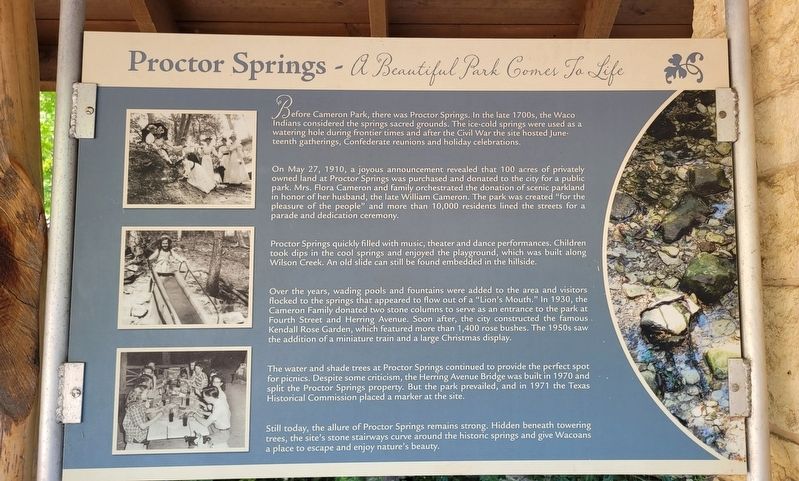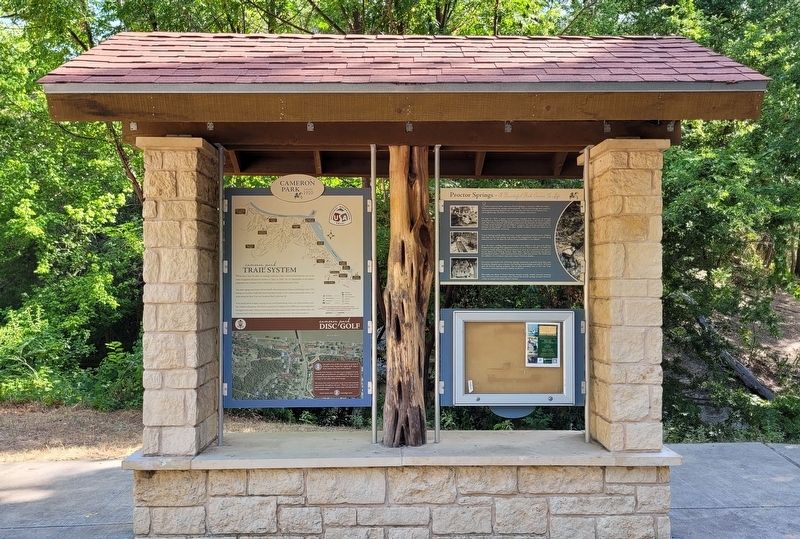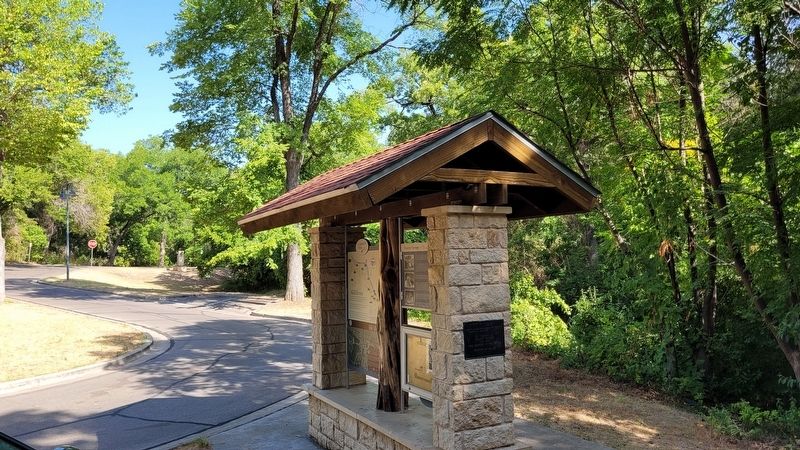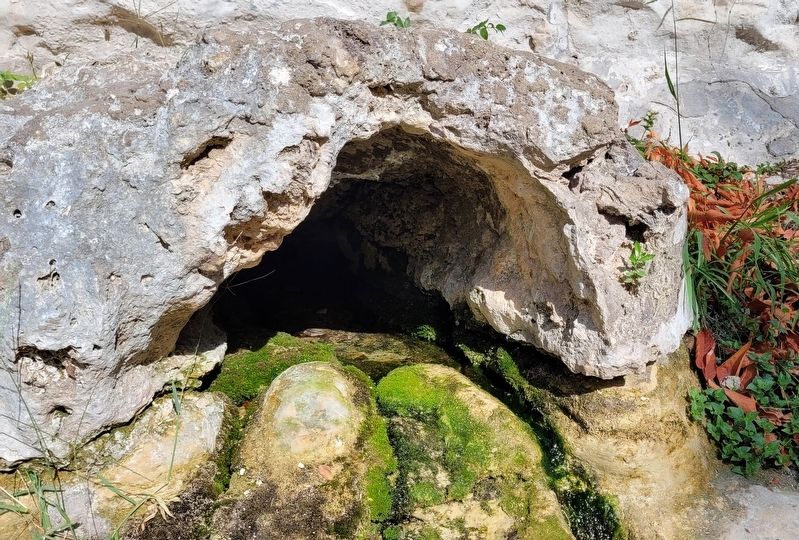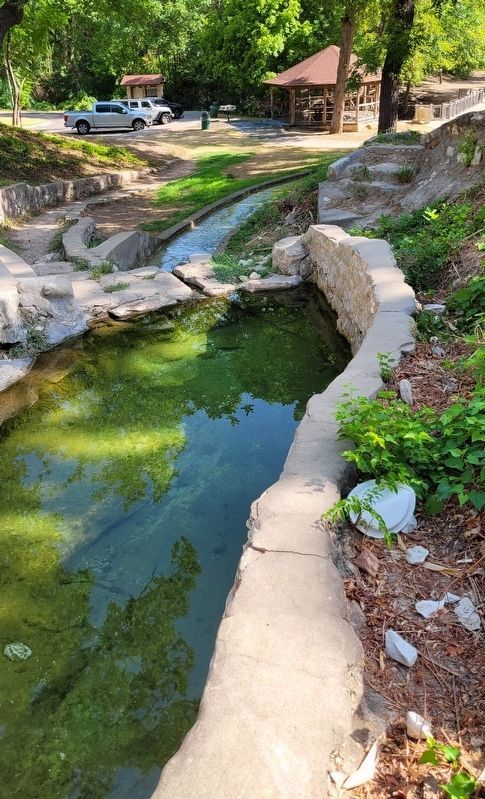Waco in McLennan County, Texas — The American South (West South Central)
Proctor Springs
A Beautiful Park Comes To Life
On May 27, 1910, a joyous announcement revealed that 100 acres of privately owned land at Proctor Springs was purchased and donated to the city for a public park. Mrs. Flora Cameron and family orchestrated the donation of scenic parkland in honor of her husband, the late William Cameron. The park was created "for the pleasure of the people" and more than 10,000 residents lined the streets for a parade and dedication ceremony.
Proctor Springs quickly filled with music, theater and dance performances. Children took dips in the cool springs and enjoyed the playground, which was built along Wilson Creek. An old slide can still be found embedded in the hillside.
Over the years, wading pools and fountains were added to the area and visitors flocked to the springs that appeared to flow out of a "Lion's Mouth." In 1930, the Cameron Family donated two stone columns to serve as an entrance to the park at Fourth Street and Herring Avenue. Soon after, the city constructed the famous Kendall Rose Garden, which featured more than 1,400 rose bushes. The 1950s saw the addition of a miniature train and a large Christmas display.
The water and shade trees at Proctor Springs continued to provide the perfect spot for picnics. Despite some criticism, the Herring Avenue Bridge was built in 1970 and split the Proctor Springs property. But the park prevailed, and in 1971 the Texas Historical Commission placed a marker at the site.
Still today, the allure of Proctor Springs remains strong. Hidden beneath towering trees, the site's stone stairways curve around the historic springs and give Wacoans a place to escape and enjoy nature's beauty.
Erected by Cameron Park.
Topics. This historical marker is listed in these topic lists: Entertainment • Native Americans • Parks & Recreational Areas. A significant historical date for this entry is May 27, 1910.
Location. 31° 34.428′ N, 97° 8.928′ W. Marker is in Waco, Texas, in McLennan County. Marker is on North Park Avenue, 0.1 miles east of North 4th Street, in the median. The marker is located at the parking lot for Proctor Springs. Touch for map. Marker is in this post office area: Waco TX 76708, United States of America. Touch for directions.
Other nearby markers. At least 8 other markers are within walking distance of this marker. Lindsey Hollow (here, next to this marker); a different marker also named Proctor Springs (within shouting distance of this marker); Redwood Shelter
(about 800 feet away, measured in a direct line); Jacob's Ladder (approx. ¼ mile away); The Clubhouse, Miss Nellie's & Anniversary Park (approx. ¼ mile away); William Cameron Park (approx. 0.4 miles away); The Methodist Home (approx. half a mile away); Mount Zion United Methodist Church (approx. ¾ mile away). Touch for a list and map of all markers in Waco.
Also see . . . Cameron Park (Waco). Wikipedia
In the early 20th century, as Waco continued to develop as the urban heart of McLennan County and the progressive movement was rising throughout America, Waco citizens began to clamor for more parks and green spaces to be preserved for public use. Many wanted to make Proctor Springs, a popular gathering site near the Brazos River that had become subject to commercialization around the turn of the century, the site of a new city park. Before the city could act, the land was purchased for $25,000 by a businessman, W.C. Lawson. Despite this apparent setback, the hopes of Wacoans to preserve Proctor Springs were not lost; on May 24, 1910, Flora B. Cameron, wife of the late William Cameron, announced that she was donating all 125 acres (51 ha) of the land to the city of Waco. Mrs. Cameron revealed that she had purchased the land with Lawson as a liaison with the intention of donating it as a park in memory of her late husband. The gift came attached with a $5,000 gift for park development, as well as stipulations to preserve the name and funding for the park, and to prohibit commercial enterprise within its borders. The park was officially dedicated on May 27, 1910, with a large ceremony attended by nearly 15,000 people. Baylor University President Samuel Palmer Brooks served as the master of ceremonies for the dedication.(Submitted on August 11, 2022, by James Hulse of Medina, Texas.)
Credits. This page was last revised on August 11, 2022. It was originally submitted on August 11, 2022, by James Hulse of Medina, Texas. This page has been viewed 472 times since then and 89 times this year. Photos: 1, 2, 3, 4, 5. submitted on August 11, 2022, by James Hulse of Medina, Texas.
